Yoga for Kidney Stones: Soothe Your Symptoms Mindfully
Practicing yoga for kidney stones can help alleviate discomfort holistically. Also, learn the various benefits yoga poses offer in improving your overall renal health.
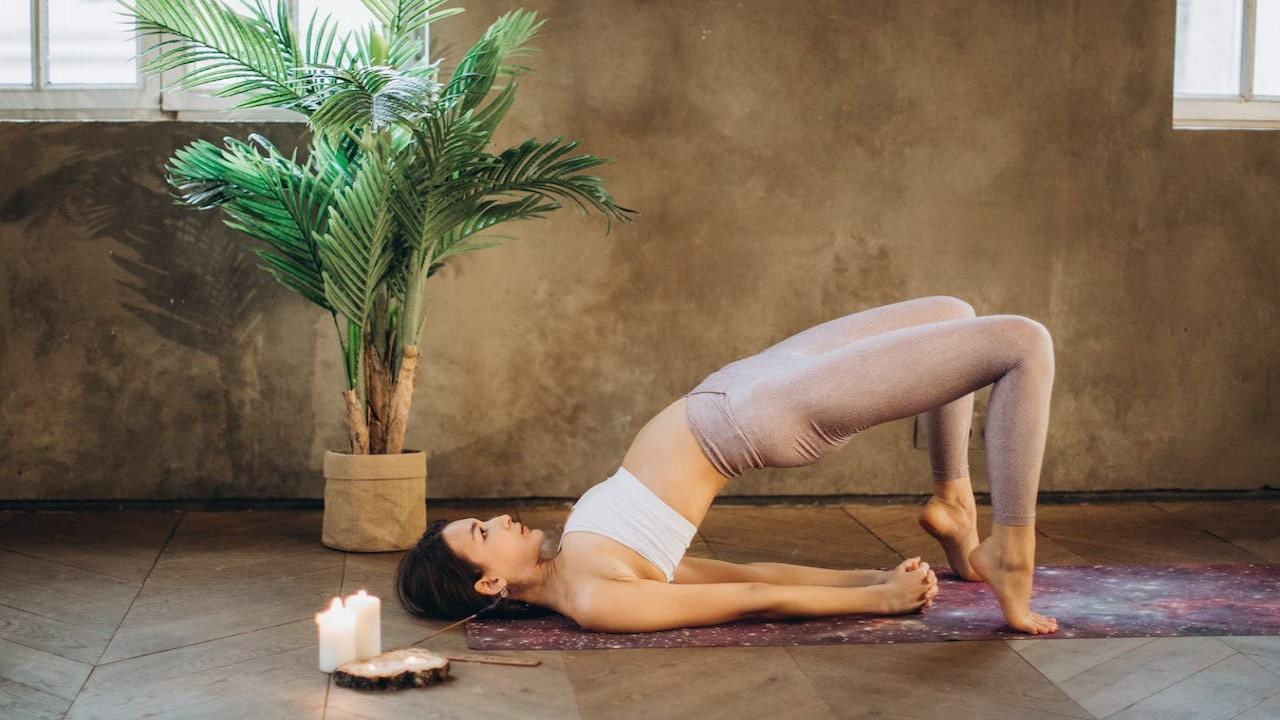
Yoga is an ancient Indian practice that offers a myriad of benefits to our overall health and wellness. Here, we will discuss yoga for kidney stones, including the various aspects and important asanas for improving the symptoms and renal function. Kidney stones develop when excessive amounts of crystal-forming substances such as calcium, oxalate, and uric acid occur in the urine. When these crystals slowly leave the kidneys, one may experience symptoms, including pain, blockage of urine flow, and feeling pain while urinating (1).
Since these crystals enter extremely narrow tubes, they induce excruciating pain and discomfort, along with other symptoms that will be discussed further. Therefore, along with clinical treatments, regular yoga practices may also be extremely helpful in managing the aching symptoms. So, let us discuss how yoga exercises for kidney stones may help improve your quality of life. However, since these are serious health issues, one must always consult a healthcare provider first to attain professional guidance rather than solely relying on yoga.
Top 5 Benefits of Yoga for Kidney Stones
Kidney stones lead to certain distressing symptoms like dull pain in the lower back or side, nausea, discomfort while urinating, etc. Since yoga asanas contain gentle flowy movements and deep breathing techniques, these may offer certain benefits in reducing painful symptoms. Here are some key benefits yoga offers for kidney stone patients:
1. May Help Boost Kidney Health
Regular yoga practice can improve blood circulation, bring more fresh oxygen to the cells, and support the body's natural detoxification processes. Poses that focus on stretching and strengthening the lower back and abdominal muscles may indirectly benefit kidney health by promoting better blood flow and overall kidney function (2). In a study done between two groups of patients, one performed yoga regularly along with conventional treatment, and the other was a control, given only medical treatments. After a period of 6 months, the first group displayed improved renal functions as compared to the latter (3).
2. May Help Relieve Pain

Kidney stones often cause significant pain as they pass through the urinary tract. Yoga poses are designed to gently stretch the muscles along with regulated breathing practices, which ultimately help relieve pain and increase pain tolerance in the long run. Deep breathing techniques in certain forms of yoga, like restorative yoga, allow the body to relax and reduce strain and discomfort (4).
3. May Help Relieve Stress
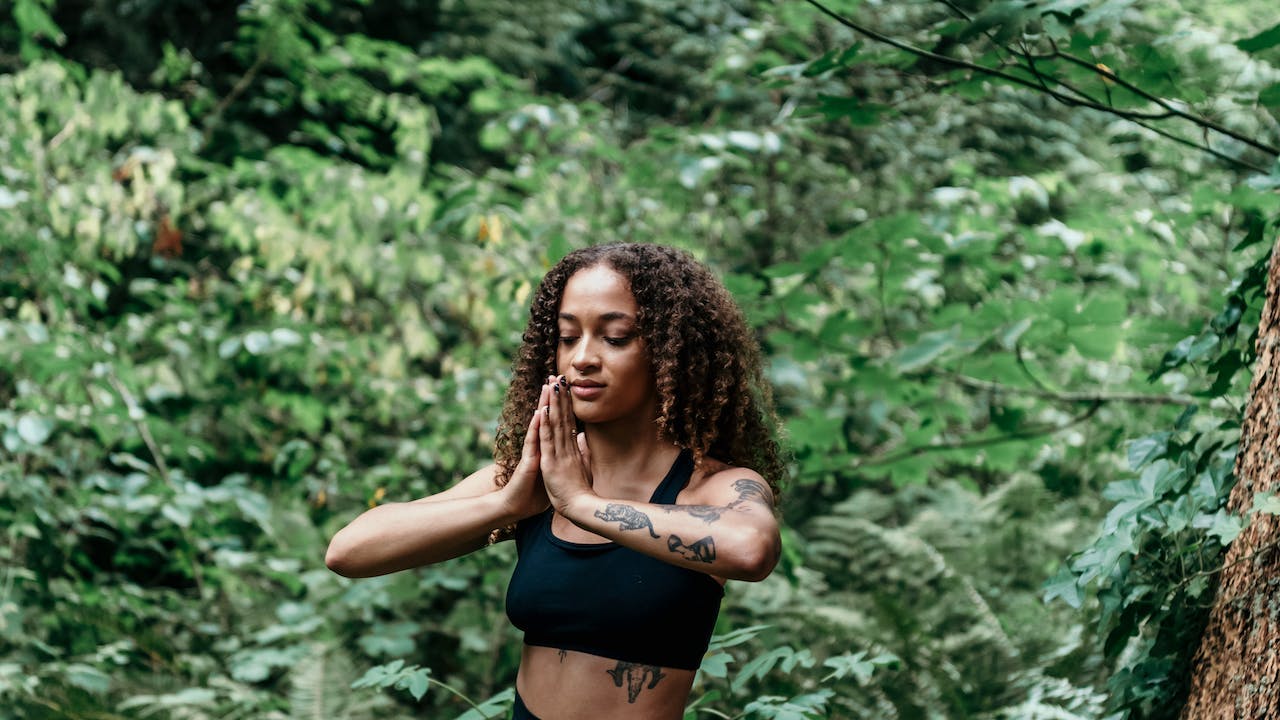
Scientists have found a correlation between stress and symptoms of kidney stones. There are various meditation exercises and breathing practices in yoga that promote mindfulness and relaxation by lowering cortisol levels in the blood (5). These have been proven to reduce stress, thus reducing painful symptoms associated with kidney stones.
“Relieving stress can promote good kidney health as well as overall well-being. Stress can contribute to high blood pressure, which puts strain on your kidneys and is a risk factor for kidney disease. Stress can also increase hormones like cortisol and hinder circulation, both of which can affect kidney function,” says Brandt Passalacqua, a C-IAYT and E-RYT500 certified yoga therapist.
“Not only that, but stress can also weaken your immune system and encourage unhealthy habits. By keeping your stress levels in check and staying healthy as a whole, you can support kidney health,” he continues.
4. May Help Promote Fluid Regulation
Proper hydration plays an essential role in kidney stone management. Some yoga poses have been shown to increase elasticity and improve sympathetic nerve activity, thus improving the body’s excretory mechanism (3). Yoga exercises may also reduce the risk factor for kidney stone formation by stimulating the internal organs, encouraging healthy fluid circulation, and preventing dehydration.
5. May Help Prevent Recurrence of Kidney Problems
While yoga is not a direct treatment for kidney stones, it encourages a holistic approach to health. Regular yoga practices will lead you to adopt healthier lifestyles with reduced stress, regulated blood pressure levels, better metabolism, and increased nutrition and hydration. These factors altogether can help prevent the occurrence of kidney stones in the future.
9 Best Poses of Yoga for Kidney Stones
Yoga poses can be beneficial for kidney stone management by promoting relaxation, reducing discomfort, and supporting overall kidney health. Here are some yoga poses that may help:
1. Child's Pose (Balasana)
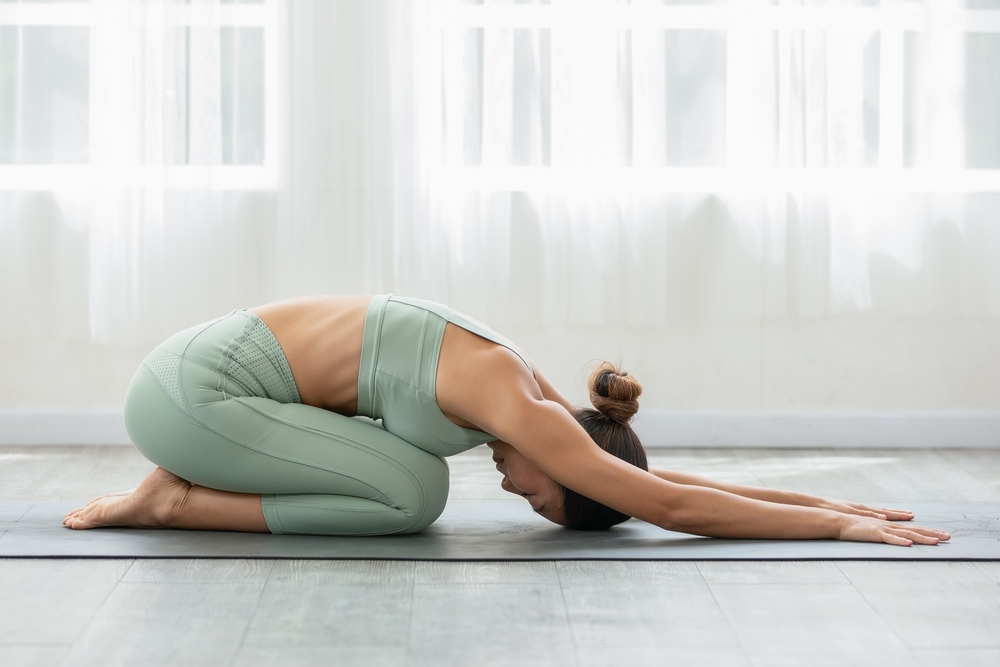
This gentle stretch is a good kidney stone relief position, as it relieves tension in the lower back and promotes relaxation.
Instructions:
- For this yoga pose, your hands and knees should be in a tabletop position, and your wrists should be positioned comfortably under your shoulders and knees under your hips.
- Take a deep breath, and, as you exhale, sit back on your heels, lowering your buttocks toward your heels.
- Extend your arms forward on the mat, with your palms resting on the floor. Your forehead should come to rest on the mat.
- Keep your knees together or slightly apart, depending on your comfort.
- Relax your shoulders and let your chest sink toward the mat. Feel the gentle stretch along your spine and the back of your body.
- Breathe deeply and hold this pose for as long as it's comfortable, focusing on relaxation and releasing tension.
- To release the pose, slowly walk your hands back toward your body and return to the tabletop position.
2. Cat-Cow Pose (Marjaryasana-Bitilasana)
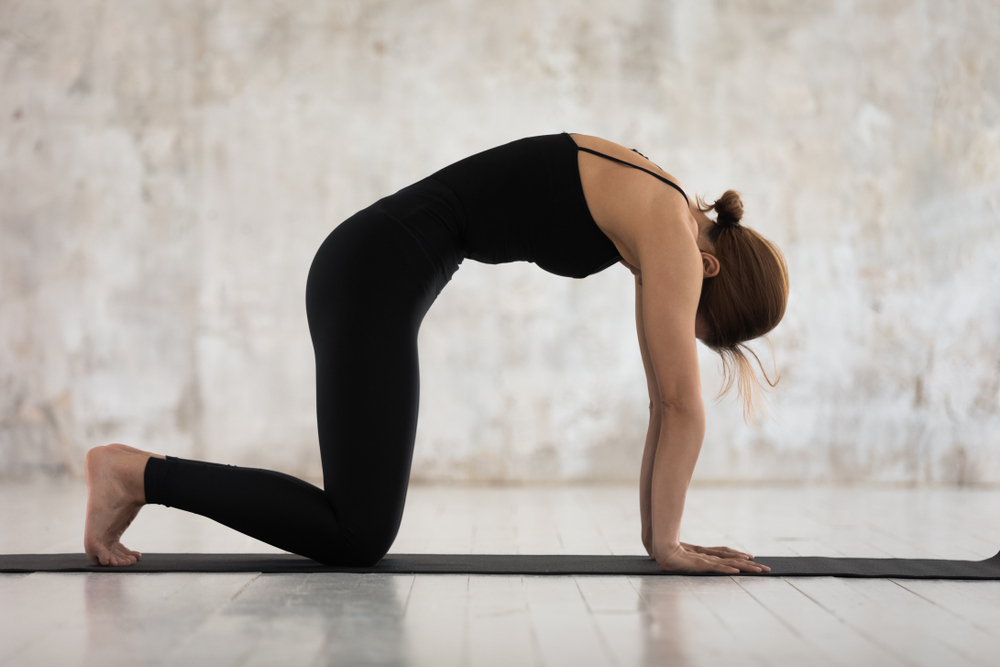
The flowing motion of these poses can massage the muscles surrounding the kidneys and help alleviate back pain.
Instructions:
- Start in a tabletop position on your hands and knees, with your wrists directly under your shoulders. Your knees should be positioned under your hips.
- Focus on breathing when doing this yoga pose — when you arch your back, you need to take a deep breath, then drop your belly towards the floor, and lift your head and tailbone, creating the "Cow" position.
- Exhale properly as you round your back, tuck your chin and bring it to your chest, and draw your belly button towards your spine, creating the "Cat" position.
- Continue to flow between these two positions with your breath, inhaling for the cow position and exhaling for the cat position.
- Repeat this fluid motion several times, allowing your spine to flex and extend, and your breath to guide the movement.
- Focus on the gentle stretch and relaxation of your back and spine as you perform the Cat-Cow sequence.
- To finish, return to a neutral tabletop position, and if desired, you can rest in Child's Pose for relaxation.
3. Supine Hand-to-Big-Toe Pose (Supta Padangusthasana)
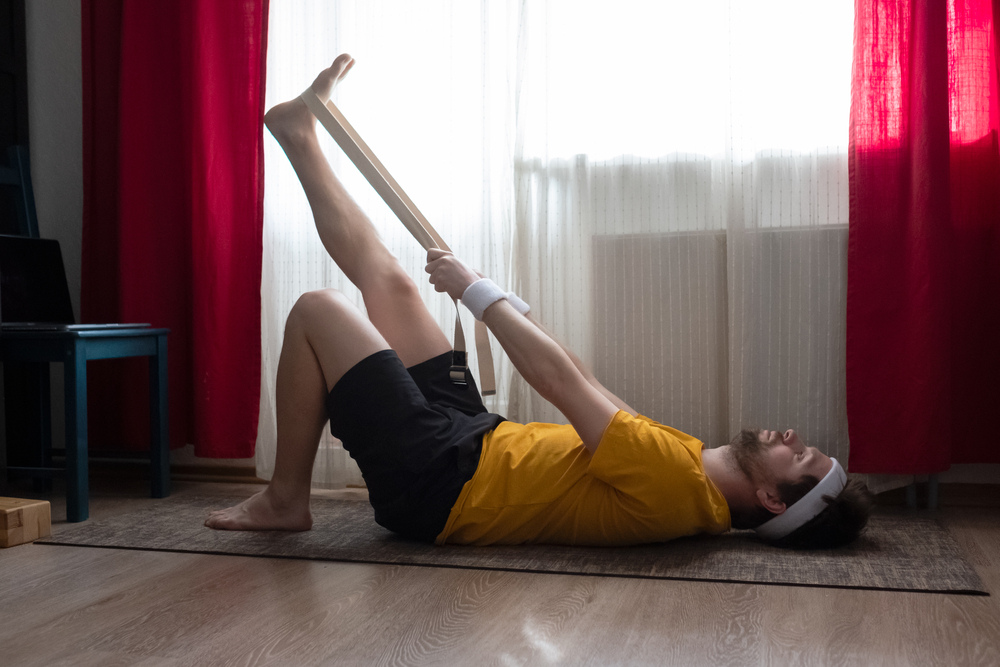
This pose is an effective exercise for kidney stones, as it stretches the hamstrings and lower back, aiding in pain relief.
Instructions:
- Lie flat on your back with your legs extended, feet together, and arms resting alongside your body.
- Bend your right knee and draw it toward your chest.
- If you can't reach your toes, use a yoga strap or a soft towel and wrap it nicely around the ball of the right foot, holding the ends of the strap with your right hand.
- While holding the strap or your toes, slowly extend your right leg toward the ceiling. Keep your left leg flat on the floor.
- Keep both legs straight and engage your quadriceps to support the extended leg. Try to keep your hips level on the floor.
- Gently pull your leg toward your head while keeping the other leg and your lower back on the mat. Hold the position and take a few deep breaths, feeling the stretch in your hamstring.
- Release the right leg and switch to the left side to perform the same stretch on your other leg, if desired.
4. Seated Forward Bend (Paschimottanasana)
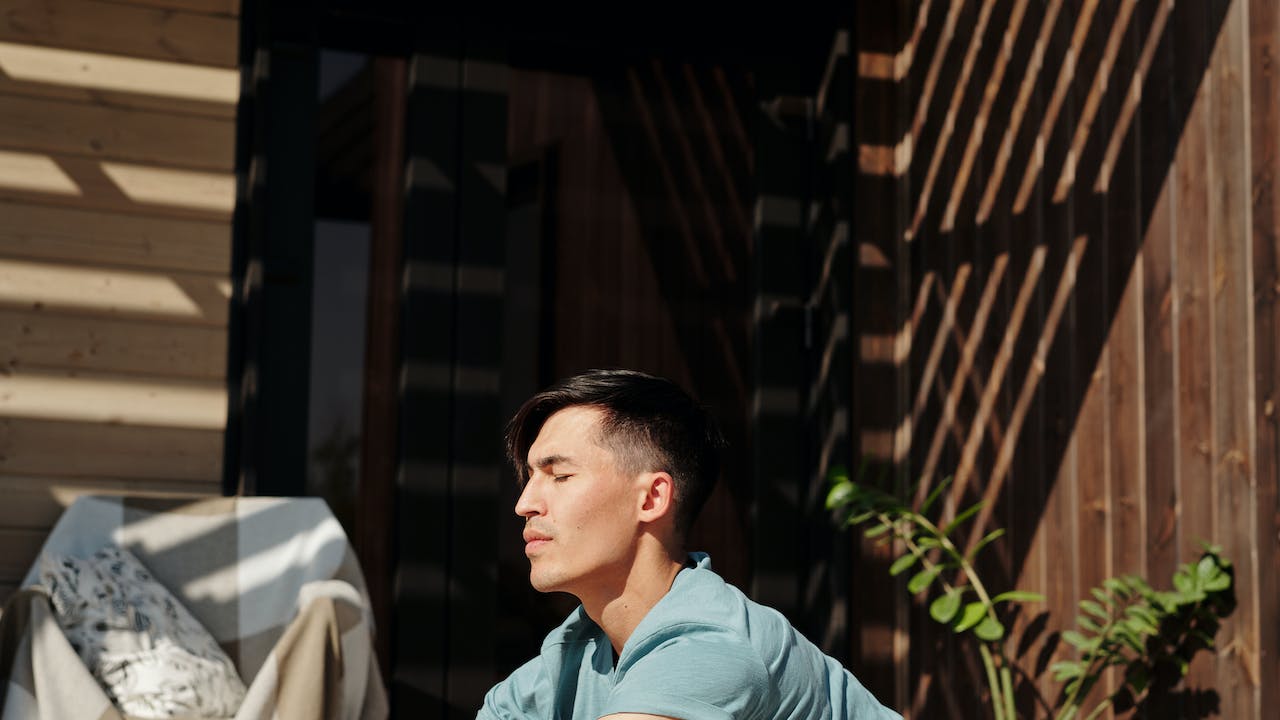
A forward bend can help ease back discomfort and make you feel relaxed.
Instructions:
- Start by sitting on the floor and extending your legs, keeping your toes pointing up.
- Sit up tall and keep your back straight.
- Inhale and raise your arms overhead to elongate your spine further.
- Exhale and hinge at your hips, leading with your chest, and reach your hands toward your feet. Keep your back straight as you fold forward.
- Hold onto your shins, ankles, or feet, wherever you can comfortably reach. Avoid forcing yourself to touch your toes if you can't reach them.
- Breathe deeply and relax into the stretch, aiming to bring your chest closer to your thighs with each exhalation.
- Hold this yoga pose for about 30 seconds while maintaining a steady, even breath, then slowly release the stretch by inhaling and lifting your torso back to an upright position.
5. Cobra Pose (Bhujangasana)
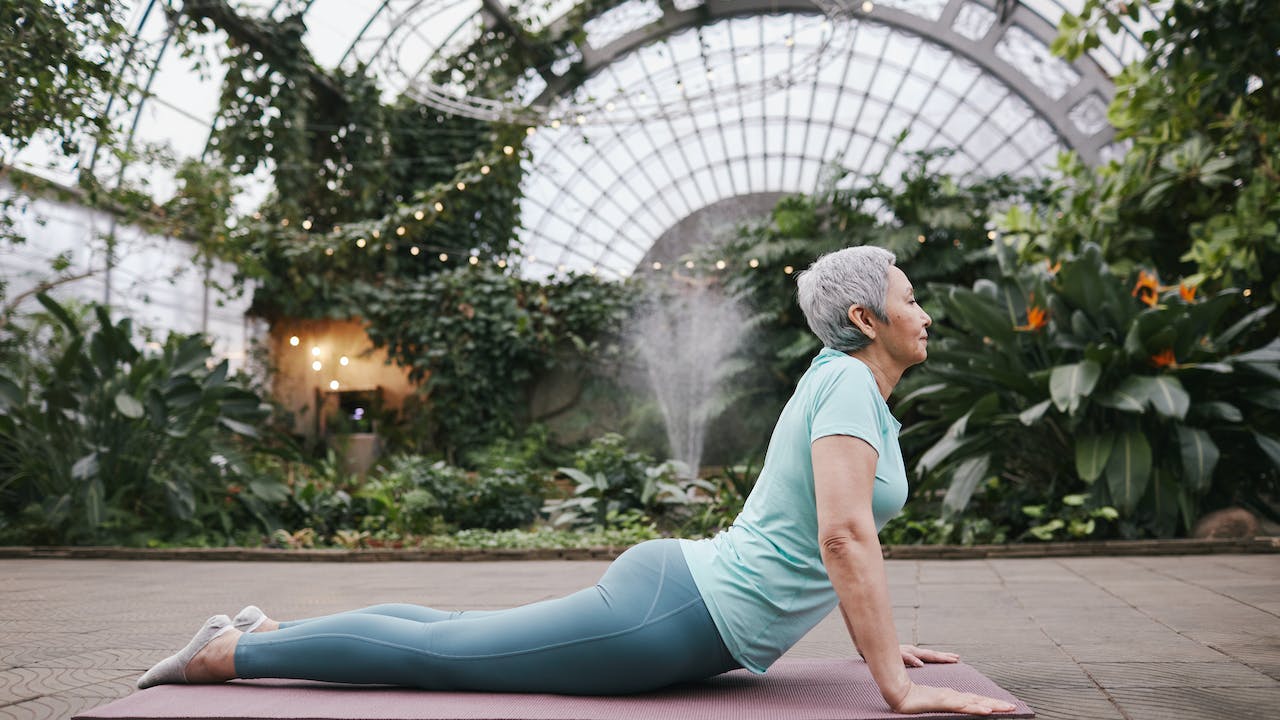
This yoga mudra can improve spinal flexibility and relieve severe pain.
Instructions:
- Begin by lying face down on your yoga mat with your legs extended and feet together. Place your palms on the mat under your shoulders, fingers pointing forward.
- Press the tops of your feet and thighs into the mat to engage your leg muscles. Keep your pubic bone in contact with the mat.
- As you inhale, slowly start to lift your chest off the mat by straightening your arms. Keep your elbows slightly bent. Use the strength of your back muscles to lift your upper body.
- Roll your shoulders back and down, bringing your shoulder blades together. Keep your neck in line with your spine, and avoid straining your neck by looking too far up.
- Continue to lift your chest, opening it up, and maintain a gentle arch in your lower back.
- Be in this pose for a few breaths, ensuring you're comfortable and not straining. Keep breathing steadily.
- To come out of the pose, exhale and slowly lower your chest back down to the mat. You can turn your head to one side and rest your forehead on the mat for comfort.
6. Bridge Pose (Setu Bandhasana)
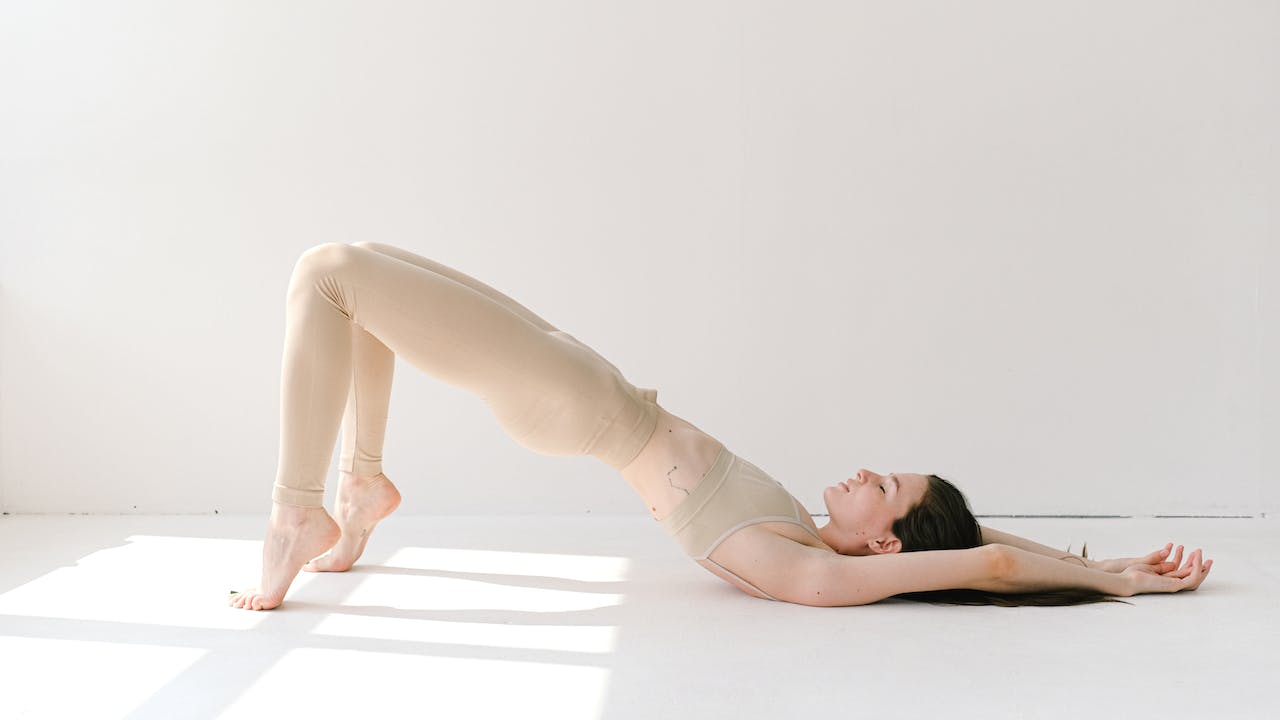
It can strengthen the back and improve kidney health by promoting blood circulation in the abdominal area.
Instructions:
- Lie straight on your back and keep your knees bent. In this pose, your feet must be hip-width apart, flat on the floor. Your arms should be alongside your body with palms facing down.
- Press your feet and palms into the floor as you lift your hips off the ground. Engage your glutes and core muscles to support your lower back.
- Continue lifting your hips until your thighs are in line with your torso, creating a straight line from your shoulders to your knees.
- Keep your chin slightly tucked to maintain the natural curve of your neck. Avoid turning your head or looking to the side.
- If you're comfortable, you can interlace your fingers beneath your lifted hips, or keep your hands on the floor for support.
- Hold the pose for a few breaths, maintaining a steady and comfortable position. Make sure you're not straining or feeling any discomfort.
- To release, slowly lower your hips back down to the floor and return to the starting position.
7. Camel Pose (Ustrasana)
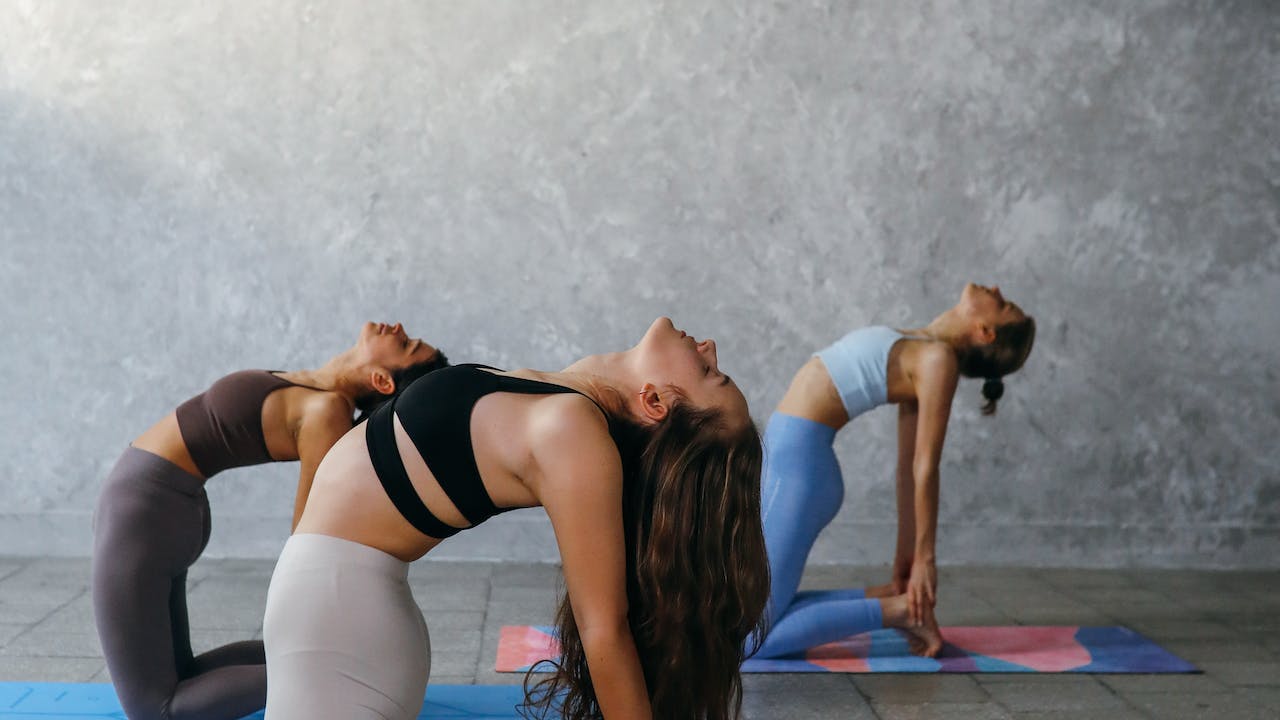
It is a popular kidney stone pain relief position in which the gentle backbend position stretches the front of the body and improves the overall flexibility of the muscles.
Instructions:
- Start by kneeling on your yoga mat with your knees hip-width apart.
- Put your hands on your lower back, with your fingers pointing downward, and then press your palms gently against your lower back for support.
- Inhale as you engage your core and slowly arch your back, pushing your hips forward.
- Keep your thighs and feet hip-width apart, and make sure your weight is evenly distributed between your legs.
- As you continue to arch your back, start to reach for your heels with your hands, one at a time, without straining or forcing.
- Hold this position for a few breaths, keeping your neck and head relaxed and comfortable.
- To come out of the pose, slowly release your hands from your heels and gently return to an upright kneeling position.
8. Supine Spinal Twist (Supta Matsyendrasana)
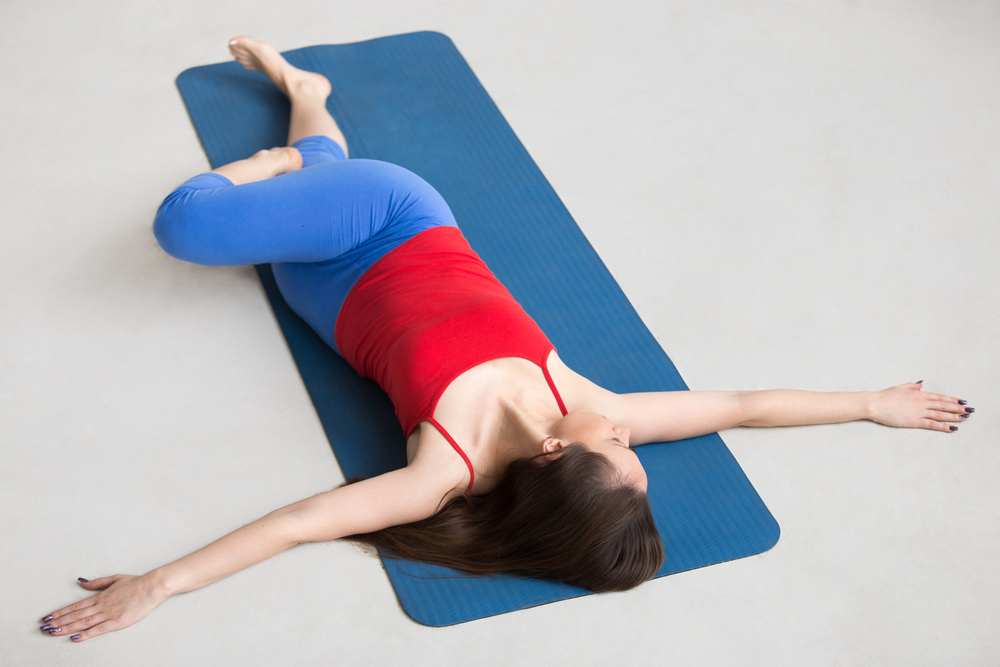
This is one of the best yoga for kidney poses that can promote gentle massage of the abdominal region and relieve tension.
Instructions:
- Lie flat on your back and keep your legs extended.
- Bend your right knee and hug it towards your chest.
- While keeping your right shoulder grounded, you’ll need to drop your right knee slowly over to the left side of the body.
- Then, you need to extend your right arm slowly and gently out to the side, in line with your shoulder, with your palm facing up.
- Turn your head to the right, looking in the opposite direction of your knee.
- Stay in this yoga pose for several deep breaths, feeling the gentle twist along your spine.
- To release, inhale deeply, bring your knee, and head back to the center. Repeat on the other side if desired.
9. Corpse Pose (Savasana)
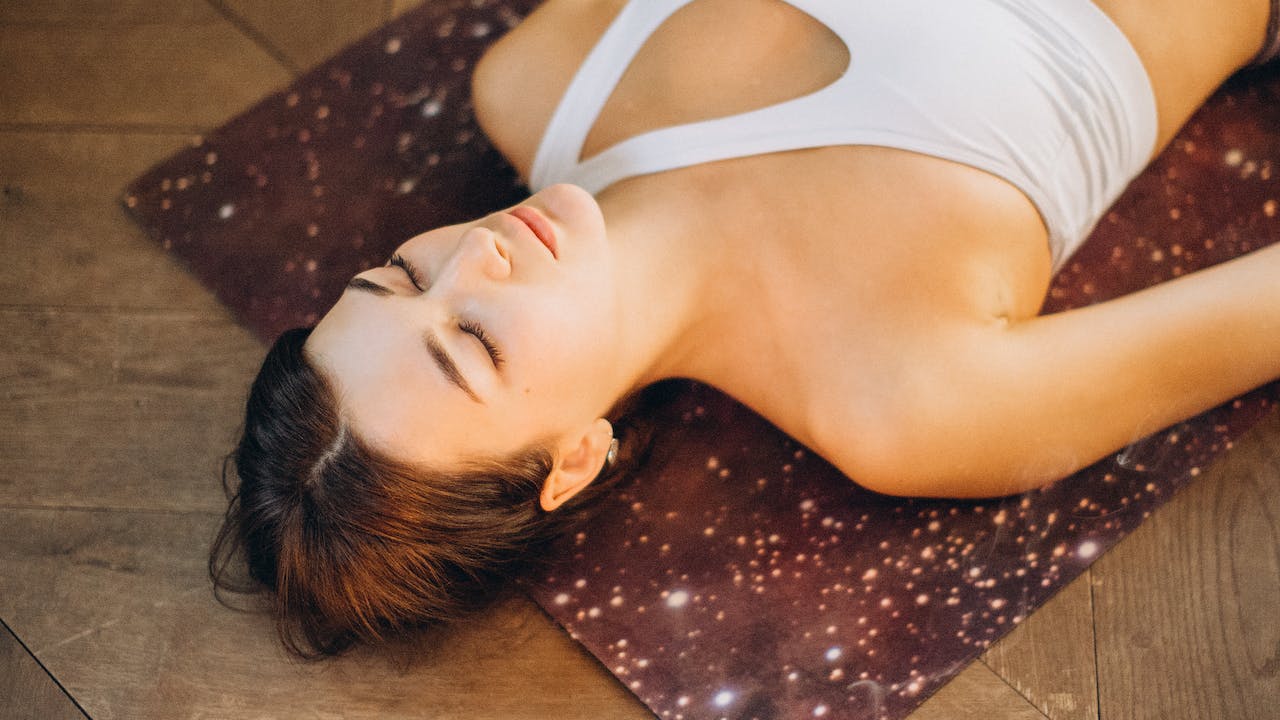
Deep relaxation yoga poses like savasana can reduce stress, which is beneficial for overall well-being.
Instructions:
- Lie down on your back on a comfortable yoga mat or a soft surface in a quiet, peaceful area.
- Keep your legs extended and your feet hip-width apart. Allow your arms to rest comfortably by your sides, with your palms facing up.
- Close your eyes and take a few deep breaths. With each exhale, consciously release tension from your body, starting from your toes and moving up through your legs, torso, and arms.
- Mentally scan your body, relaxing any areas of tension or discomfort. Let go of any gripping or holding in your muscles.
- Pay attention to your breath. Breathe naturally and gently. Observe the rise and fall of your abdomen with each breath.
- If your mind starts to wander, gently bring your focus back to your breath and the present moment.
- Remain in this for 5 minutes and enjoy the deep relaxation and rejuvenation it provides.
Yoga Poses to Avoid if You Have Kidney Stones
“Always check with your doctor before practicing yoga if you have kidney stones. You will likely need to avoid any movements that could cause pain, such as deep twists or yoga poses that put pressure on your abdomen,” continues Passalacqua.
He further adds, “Gentle yoga poses and relaxing breathing techniques may be a safer bet while you have kidney stones. You should also make sure you stay hydrated. Listen to your body and stop if you experience pain while practicing yoga.”
When you have kidney stones, it's important to avoid yoga poses that put excessive strain on the kidneys or may cause discomfort. Here are some yoga poses to avoid:
- Backbends: Deep backbends can compress the kidneys, potentially causing discomfort, so it's best to avoid poses like a full wheel (Urdhva Dhanurasana) or camel pose (Ustrasana)
- Twists: Deep twisting poses may put pressure on the kidneys and may not be suitable, so avoid postures like seated spinal twists (Ardha Matsyendrasana).
- Intense inversions: Inversions like shoulder stand (Sarvangasana) and headstand (Sirsasana) can place pressure on the abdomen and kidneys and should be approached with caution.
- High-intensity poses: Poses that require a lot of strength and effort, such as advanced arm balances, may not be suitable if they cause strain and discomfort.
- Dehydration-inducing poses: Hot yoga or practices that lead to excessive sweating can potentially lead to dehydration, which is not advisable for kidney stone prevention.
Conclusion:
Yoga for kidney stones is an effective and simple way of combating the uncomfortable symptoms one continuously lives with while dealing with this medical issue. Yoga not only helps to relieve physical strain through stretches, but it also induces tranquility and mindfulness through pranayamas and deep breathing asanas. So, it equips you with exercises to attain physical comfort along with a more resilient mind and calmer soul to endure the pain better. Although most gentle exercises are usually safe, one must be careful to practice extreme bending, high-intensity, or twisting exercises, as they may exacerbate the symptoms. Moreover, one must visit a healthcare professional and not solely rely on yoga to improve the condition. Make sure to increase your fluid intake if you have urinary disorders or kidney problems. So, our final advice for you is to incorporate yoga along with medical treatments and changes in your mindset, diet, and lifestyle to experience maximum benefit.
Contributor: Brandt





 JOIN OUR WHATSAPP CHANNEL
JOIN OUR WHATSAPP CHANNEL






















































